
Sitting meditation and t'ai chi (taiji) complement each other. I believe the deepest, ultimate goal of both is to knit together our conscious and subconscious so that we become all one thing. By transcending the separation between material and immaterial, we can indeed become one with the universe.
Meditation and t'ai chi put us in touch with the dan tian, the primary reservoir of qi in the middle of the abdomen. I see the dan tian as the conductor of the body/mind/spirit orchestra, and my umbilical cord to the universe. It is the Tao (Dao) within me.
My favorite time to meditate is in the morning before breakfast. Sometimes I precede sitting meditation with strenuous physical activity—running or stretching—then slow down with t'ai chi or qigong, and finally arrive at stillness while sitting. The vigorous exercise gets cleansing, stimulating circulation going and vents physical tension. T'ai chi, qigong, and breathing exercises slow me down, calm me, and get me ready to be still. Sometimes it's clear to me that I need no preliminaries—I'm ready to simply sit and drop down into stillness.
Here's a brief and simple exercise that I teach to all my T'ai Chi students because of its remarkable benefits. This one comes from Dr. Andrew Weill, a Harvard-educated medical doctor who's a well-known advocate of complementary and alternative medicine. He says this is the most effective anti-anxiety exercise he knows and he teaches it to almost all his patients. Some students tell me it slows their heart rate; others say it helps them get to sleep or restores their equanimity when they're upset. It can be profoundly calming anytime and is an excellent prelude to meditation.
You can do this exercise standing, sitting, or lying down. In any position, make sure the spine is straight, right up through the back of the neck. If you're sitting, place the feet flat on the floor in front of you and let your hands rest on your thighs. If you're standing or lying down, let your arms rest at your sides.
There are three phases to this exercise, and I've found that giving focused attention to each one increases the effectiveness. First is a period of introduction. Get comfortable with a straight back. Place the tip of the tongue on the roof of the mouth, just behind the teeth (in the "Yogic" position) and hold it there. Make your breath slower, deeper, quieter, and more regular. This could last for several breaths or several minutes and gradually brings a very noticeable change to your inner state. Already you feel more relaxed and centered.
Next is the 4-7-8 exercise. Keep the tip of the tongue on the roof of the mouth—whether you're breathing in, holding your breath, or breathing out. Holding your tongue here while breathing out can take some getting used to. It helps to purse the lips so you can blow the air out around the tongue. You will inhale through the nose quietly (with a closed mouth) and exhale through the mouth noisily (with the mouth open). Begin by exhaling completely through the mouth. Then breathe in through the nose for a count of four. Dr. Weill doesn't mention this, but I use belly breathing—expanding the abdomen first, then filling the lungs, and contracting the abdomen to exhale. Hold the breath for a count of seven. (It feels as if you have filled yourself up to the level of the collar bone.) Breathe out through the mouth gradually for a count of eight. Do this for four breath cycles.
Finally, the third phase: Spend some time breathing normally and noticing how you feel. Scan your body, acknowledging everything it's saying to you—good and bad—without trying to change or deny anything. I feel this prolongs the state of stillness and gives me a chance to learn some things about myself—physical, and emotional.
Count at a rate that's comfortable for you. The actual time each breath cycle takes is not important—it's the 4-7-8 ratio that's important. Notice that exhalation is twice as long as inhalation. We have many more intercostal (inter-rib) muscles that control exhalation than we have that control inhalation, so breathing out more slowly than we breathe in is natural.
Feel lightheaded? Breathe more gently and shallowly. Adjust your rate of counting. The lightheadedness will go away with practice. You'll also find your lung capacity increasing.
Do this exercise a minimum of twice a day for a month. Then increase the breath cycles to eight and continue to do it at least twice a day. Doing it more than twice a day is fine, but don't go beyond eight breath cycles. Each practice is cumulative. The exercise gains effectiveness over time.
How to account for the striking effectiveness of this exercise? There are various ways of working with qi in the body. When we do T'ai Chi, we move continuously and try to keep the qi flowing without obstruction. But in other qigong exercises, we deliberately stop the flow of qi temporarily. Wen Mei Yu, a Chinese T'ai Chi master teaching in this country, describes it this way: There's a hose on the ground with water running through it. I put a foot on the hose and stop the flow. Pressure builds up on one side. When I remove my foot, the water gushes through and cleans out the hose. In this way qi cleans out the meridians or pathways of qi and massages them with a peristaltic action. It seems to me that this is what we're doing when we breathe in deeply, hold our breath, and then exhale slowly and fully.
Also, according to neuropsychologist Rick Hanson, PhD, "When you elongate your exhalations, you spark your parasympathetic nervous system, which slows down your heart rate." (The parasympathetic nervous system is engaged when we feel calm, secure, and peaceful; the sympathetic is engaged when we're in a state of fight-or-flight alarm.)
We live in a world with too much yang (friction, heat, activity), and not enough yin (smoothness, coolness, stillness). I have the sense that this exercise replenishes yin by bringing in new qi with the inhalation, and vents excess yang with the exaggerated exhalation. It helps bring up the level of yin and draw down the level of yang so that they match each other and are in balance. The 4-7-8 exercise restores our inner equilibrium.
—Margaret Emerson T'ai Chi
I can also achieve a state of unity and transcendence with very slow, focused t'ai chi or qigong practice—they're moving meditation.
I think it's important to bathe before sitting, to wear clean clothes, and to have a special, very comfortable garment reserved for meditating. It should be a color that is currently soothing and alluring to you.
There are many positions that can be used for meditating. Maintaining a straight back from the tailbone up through the back of the neck is the main thing I stress. The crown is uplifted which means the chin naturally points down toward the heart. The lower back is flat. The tongue rests on the palate, just behind the front teeth. Full lotus, half lotus, cross-legged, legs extended out in front, sitting on a cushion, bench, chair, or even lying flat are all possibilities. I subscribe to the idea that being comfortable while meditating assists in the process of becoming truly still. I don't believe being uncomfortable or enduring pain—such as in the knees in full lotus—is anything other than an unnecessary distraction, not to mention potentially damaging to the body. And because the body, mind, and spirit are inseparable, damage done to one is damage to the others. A preoccupation with holding a prescribed form denies the infinite particularity of each individual and inhibits the process of internal exploration. We can try out whatever we like, combine elements that suit us, and devise our own eclectic ways.
Many years ago I attended a Yoga retreat. During lunch, I was talking with a couple other participants who were devotees of the person leading the retreat. One told me that when she meditated, her arms felt as if they wanted to rise. But she didn't let them do that because that would be breaking the form laid down by her teacher. What a shame, I thought. I often have the same impulse and I always let my arms do whatever they want—I'm curious to see how high they'll go and where and how and when they'll come down. It's not just my arms that move—my body rocks and circles; tears or smiles may appear on my face. This is part of the intrigue, the mystery, and the fun of meditation. It's how we gain authentic information about ourselves.
Some people say it isn't possible to stop thinking. I disagree. Now and then I reach that point. I have two ways of describing it and they sound like direct contradictions of each other. One is that I'm being suctioned out of ordinary space and time and flung into something else—some existence that doesn't have space and time. Another is that a gate opens and raw energy gushes into me, blotting out everything else. I vanish. This "door" may open and close repeatedly while sitting or doing t'ai chi. It's beyond sensation or accurate description. It frightens me (because my self is obliterated), and it thrills me. When I experience this loss of self, duality is transcended; there is no longer subject and object; me and not-me; movement and stillness. It is complete integration of material with immaterial. If I'm doing t'ai chi, the dancer becomes the dance.
Every day is different. Sometimes I'm ready to sink into my dan tian as soon as I sit down. But normally I need to use breathing exercises—like slowing and deepening my breath—to usher me into a quieter state. I may also silently repeat two words that appeared to me in a vision—my own mantra—the first word with inhalation, the second with exhalation.
From there I often use healing colors. It's a technique I learned in my original experience with natural healing thirty-five years ago. Green, blue, and yellow are the most effective healing colors—in that order. I put myself into a place and time of my choosing, saturating myself with a particular color. It's important to know that I can be where I want to be when I want to be.
The following is my own way of using the colors—just an example. People will have their own most penetrating experiences and memories—or imaginings—involving these colors. (also see "4-7-8 Breathing" sidebar in this article)
I bracket the colors with white light (which I see as the color of qi itself), beginning and ending with it:
I am the white light; I glow with white light; I am the seed, the core, the center, the focus, the source, and the receiver. The white light is dense and compact and powerful within me. All the white light of the universe comes and goes through me, into and out of my center, my dan tian. From the moon and stars; the oceans, lakes, rivers, and streams; from the forests, trees, rocks, and mountains; and from all the inhabitants of Earth, the white light comes and goes through me. It's easy. I simply breathe it in and breathe it out. I am surrounded by a sphere of white light that feeds me and protects me. (A teacher once told me to imagine the sphere at least twenty-four feet in diameter.)
I stay with this image and breathe the white light for as long as I like, then I go to blue, making it the first color because of its calming, comforting qualities.

I'm stepping out of the forest and onto the sands of Washington Island in Green Bay, Wisconsin. It's August; it's vacation. The tiny, sun-warmed, light-colored grains of sand roll and crunch under my bare feet. As I arrive at the water's edge, unclothed, I turn my palms outward and open my eyes and skin to absorb the wavering sapphire-blue water and sky-blue sky. My arms rise by themselves and I float up into the air over the bay. I start to expand, particle by particle, both warmed and cooled by the infusion of blue light. Everything softens, loosens, spreads out, until it's no longer possible to see the outlines of my body. I hover over and dip lightly into the water. Every particle of my body is caressed and perfected by the blue light; cleansed, purified, soothed, and massaged. I look at a single radiant particle and know that all the other particles that make up my body are equally illuminated with the force of healing blue light. I focus the blue on parts of my body that need help just now. Toxins and poisons—physical, emotional, and spiritual—fall away. All that's left is the best and purest of my being. I glow with blue light. I am the blue light. This is the color of serene strength and confidence. I stay here as long as I like.
Then I move on to green. I touch down on lush spring grass, open up the centers of my feet—the yong quans or "bubbling wells"—and let renewing green light course through me like a river—washing, cleansing, soothing, massaging, nourishing, healing. Again, I give special attention to any part of my body that requests it.
The emerald green light flows out through the crown of my head and the tips of my fingers that are held upward like the branches of a tree. I'm in the Shakespearean Garden of Portland's Rose Garden. I lie down beneath a maple tree, green sunlight filtering through its leaves, blanketing me from above. I'm buoyed by the elastic tendrils of grass under me, seeing and feeling their vitality penetrate through my back, my limbs, my head. Green is the color of growth and regeneration and persistent life. I linger here.

Then yellow. I get up and walk to where the roses are planted by the thousands. I look for the most beautiful yellow rose that I can find. I put my face up to it, breathe in its fragrance, and stare into its depths. It pulls me in, draws me into its center, and envelops me in a quiet, velvet, golden intensity. I lose my self. I enter the rose and the rose enters me. I can feel its golden warmth, its gentle power radiating outward from my center to heal my entire body. It fills me; I feel replete. There I am, sitting in the center of the rose with the rose sitting in the center of me.
I always end with white: I am the seed, the core, the center, the focus, the source and the receiver of all the white light—the qi—in the universe. From the moon and the stars; from the mountains, trees, lakes, rivers, oceans, and streams; from the earth itself and all the beings that inhabit it, the white light easily comes and goes through me. I simply breathe it in and breathe it out. I'm filled with white light. I am the white light. A huge sphere of white light surrounds me, feeding and protecting me. And the center of all this is my center, my dan tian.
Now there's nothing more to be done. I settle into the dan tian and simply maintain my presence there. "Be at Peace," I say to myself. "Be at…" "Be…" I drift. Thoughts appear and I watch them, take note, stop in midthought, and return to the dan tian. My breath is quiet. I become still. n
Reprinted from Winter 2014-2015 Qi Journal
Margaret Emerson has been practicing T’ai Chi, qigong, and meditation since 1979 and teaching since 1989. Margaret’s new book is Laotse, Waldo, and Me, her conversation with the author of the Tao Te Ching and Ralph Waldo Emerson on topics of interest to all three. These include the Tao, the Sage, the Inner Guide, Wu Wei, Unlearning, and Balance. It’s available on Amazon, through bookstores, and from the author. Margaret’s other books are A Potter’s Notes on Tai Chi Chuan, Breathing Underwater: The Inner Life of T’ai Chi Ch’uan, and Eyes of the Mirror (a memoir). She is a contributor to the book Martial Arts Teachers on Teaching, also to Qi Journal, Aikido Today, and Black Belt Magazine. Her video is “Wu T’ai Chi, Kao Style: As Practiced and Taught by Margaret Emerson.” Contact her at www.margaretemerson.com or Tel: (707) 822-6508.


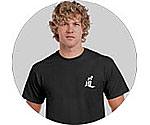 Imprinted Apparel
Imprinted Apparel

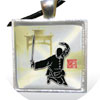
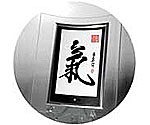 Framed Calligraphy
Framed Calligraphy Caligraphy Jewelry
Caligraphy Jewelry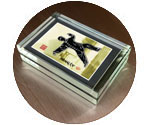 Paperweights
Paperweights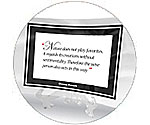 Proverbs & Quotations
Proverbs & Quotations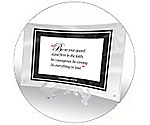 Bible Verses
Bible Verses Moringa Products
Moringa Products